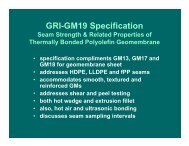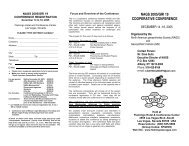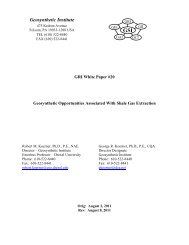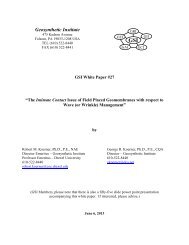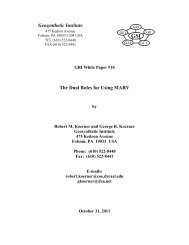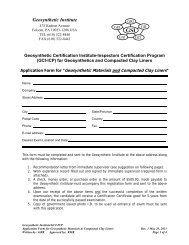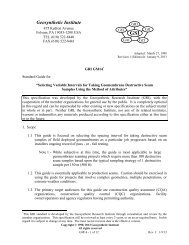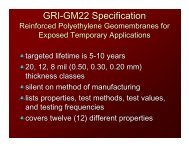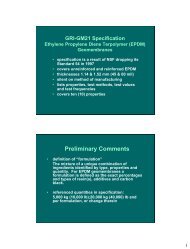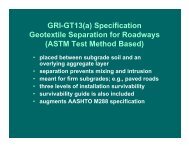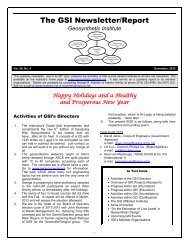GCL Design Guide - The Geosynthetic Institute
GCL Design Guide - The Geosynthetic Institute
GCL Design Guide - The Geosynthetic Institute
You also want an ePaper? Increase the reach of your titles
YUMPU automatically turns print PDFs into web optimized ePapers that Google loves.
10.2 Cation Exchange<br />
remain unchanged. In landfill liners beneath a waste mass, <strong>GCL</strong>s<br />
subjected to high confining stresses are felt to be less vulnerable to<br />
increases in hydraulic conductivity than <strong>GCL</strong>s in low confining stress<br />
applications, e.g., less than 20 kPa.<br />
10.2.1 If a liquid containing significant electrolytes [for example, potassium<br />
(K+), calcium (Ca++), magnesium (Mg++), and aluminum (Al+++)<br />
cations] percolates down to and through a <strong>GCL</strong>, these positively charged<br />
cations will preferentially exchange with the sodium (Na+) cation in the<br />
bentonite of the as-manufactured <strong>GCL</strong>. This is referred to as cation<br />
exchange. It is somewhat controlled by the role of RMD, the ratio of<br />
monovalent to the square root of divalent ions. <strong>The</strong> phenomenon results<br />
in reduced swelling capacity (according to ASTM D 5890) and increased<br />
hydraulic conductivity of the bentonite. <strong>The</strong> higher the charge (or<br />
valence) of the cation, the more preferential and readily it will exchange<br />
with the Na+ cations within the bentonite structure. It should be<br />
recognized that most soils contain an abundance of salts that contain<br />
significant concentrations of K+, Ca++, Mg++, or Al+++. <strong>The</strong> least<br />
favorable cations with regard to exchange of Na+ in bentonite are the<br />
polyvalent cations. <strong>The</strong>y have a charge of +2 or more.<br />
Note 9:<br />
While there are several technical papers on the topic of cation<br />
exchange in sodium bentonite <strong>GCL</strong>’s, the studies by Kolstad, et<br />
al. (2004, 2006) are quite comprehensive and illustrate the<br />
potential seriousness of the situation.<br />
10.2.2 Free available calcium or magnesium from the surrounding soil will<br />
produce an ionic exchange within the sodium bentonite of the <strong>GCL</strong> within<br />
a time period of a few years depending upon site-specific conditions. It is,<br />
therefore, recommended to investigate closely the ionic content of the<br />
cover soil over <strong>GCL</strong>s, the cover soil thickness, and the type of bentonite<br />
for effects on the <strong>GCL</strong>’s hydraulic conductivity.<br />
10.2.3 ASTM <strong>Guide</strong> D6141 is used as a screening tool for determining the<br />
potential for a liquid or soil to impact a <strong>GCL</strong> insofar as ionic exchange is<br />
concerned. In D6141, sodium bentonite is tested for swell index (ASTM<br />
D5890) and fluid loss (ASTM D 5891) with a test liquid instead of<br />
deionized water. <strong>The</strong> test liquid is either the site-specific liquid or a<br />
synthetic liquid derived from the adjacent soil. Laboratory research by Jo,<br />
et al. (2001) has indicated that free swell tests can be a valuable tool for<br />
estimating how inorganic aqueous solutions affect the hydraulic<br />
conductivity of non-prehydrated <strong>GCL</strong>’s, see Figure 9.<br />
<strong>GCL</strong>5 - 18 of 34 Rev. 1: 1/9/13



